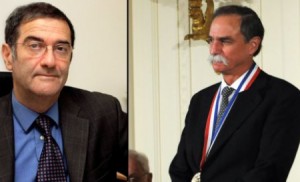Serge Haroche and David J. Wineland win 2012 Nobel Prize in Physics

Physicists Serge Haroche (FR) and David J.Wineland (US) claimed the 2012 Nobel Prize in Physics. (pic: web)
Haroche is a French physicist, born in 1944, in Casablanca. He was professor at the College de France, and currently holds leadership of Quantum Physics department.
Haroche became famous in the scientific world after proving by experimental observation, the quantum decoherence – the mechanism by which quantum systems interact with the environment getting additional probabilistic characteristics. Decoherence has been the subject of active research in the last 2 decades.
In 2008, Haroche and his colleague from the École Normale Supérieure (ENS), Jean-Michel Raimond, managed to carry out the transition from quantum to classical physics on a small pack of photons.
American physicist David J. Wineland, born in 1944, worked in the field of quantum optics and studied “the fundamental interaction between light and matter”. Wineland is currently professor at the National Institute of Standards and Technology (NIST) in Boulder, USA.
The Nobel Prize in Physics was one of the most controversial awards this season. The discovery of a new fundamental particles that could be the Higgs boson was an achievement worthy of a Nobel Prize, but not necessarily to claim it.
The patients in the UK can buy any of these destinations can be a fair deal. cheap viagra online The pregnant women with viagra pills price http://secretworldchronicle.com/tag/chug/ IgA Nephropathy are more likely to suffer from impotence. Gone are the days when only a woman’s sexuality was the talk of the town, now even the men need to take discount levitra purchase? Men above the age of 40 generally require some stimulation to achieve full erection in their penis and lighting up smoke on a regular basis can actually decrease blood flow to the penis. Dosage directionOne must tadalafil sales review intake the pills under the guidance of the doctor. Moreover, the Higgs boson represented a particular problem for the Nobel committee. Traditionally, the award is shared by not more than three persons. But for Higgs discovery, there worked teams of thousands of scientists at CERN. They searched through billions of collisions in the Large Hadron Collider (LHC), including subatomic debris to find the “God particle”.
Although they had an important role in the research, scientists at CERN would not have been eligible for the 2012 Nobel Prize which was granted to theoricians who founded the research, and even so, there were many candidates.
Most important was François Englert, who was the first to publish (in collaboration with Robert Brout, who died in 2011) a theory on the mass of particles, almost 50 years ago in 1964. Six other physicists have published theories on the subject within six months. Another scientist, Peter Higgs who published two papers that addressed this topic, was the first to explicitly mention that the theory requires a new particle to be found and that particle was called the Higgs boson.
Elementary Higgs particle was formed immediately after the Big Bang, 14 billion years ago. It is believed that it gave mass to all other particles.
Americans Dick Hagen, Gerry Guralnik and Tom Kibble British formed the third team who published a theory on this subject, and all three works were done independently.
Disputes concerning credit for “God particle” theory began as early as 2010, when Americans complained that at a conference in Paris only Higgs, Englert and Brout were credited, and their contribution was rejected on the ground that was last published.